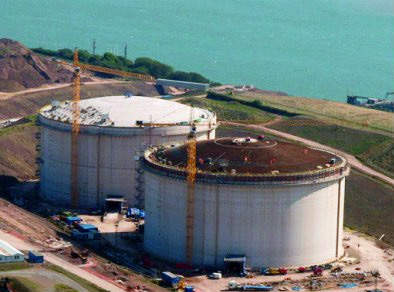
Dragon LNG Ltd has developed an LNG import, storage and regasification terminal in Waterston, Milford Haven, Wales on the site of an old refinery. Construction of the new terminal was completed in August 2009 and the operations began immediately.
The Waterston site was formerly the Gulf Oil Refinery which operated from the mid-1960s until 1997, when refining operations ceased. 4Gas acquired the site in 1998, as part of its purchase of Gulf Oil Refining Ltd UK from Chevron. Since that time the site has operated as 4Gas Tankstorage Milford Haven Ltd, providing storage and other services relating to the oil and energy industry.
The new facility has a start-up capacity of 6bn cubic meters per annum (bcma) and has been in service and accepting imports since 2009. The shareholders in this project are 4Gas BV (20%) (Founder) and its customers BG Group (50%) and Petronas (30%). The gas exporting partners have 20-year arrangements governing the use of capacity rights, which allows each company to throughput 3bn cubic metres (106bn cubic feet) of gas a year, equivalent to around 2.2m tons of LNG per year.
The start-up capacity of the new terminal provides up to 5% of natural gas demand in the UK. Construction of the £250m facility began in 2004 following an intense environmental regulation process. Proposed LNG terminals in the UK are subject to control by the Control of Major Accident Hazards (COMAH) regulations and must demonstrate it meets these requirements to a health and safety executive before any plant can be operated.
UK demand for gas
Over 18m homes in the UK use natural gas and a significant proportion of UK electric power is generated using natural gas. The demand for energy and natural gas is now increasing at a time when the UK’s domestic production from the North Sea is in the decline (although not due to run out for some years). The import of LNG via new LNG terminals and storage facilities will help to close the growing gap between supply and demand.
The principal of the project 4Gas are involved in about five other LNG projects around the world including some in the Netherlands, US and Canada. The other partners in the project, BG Group and Petronas, are among the world’s leading LNG exporters, who collectively own the largest fleet of LNG ships.
Logistics
LNG is delivered to the new Milford Haven terminal by a fleet of LNG carriers / ships, which berth at one of the two refurbished jetties. The LNG carriers can carry up to 145,000m³ of LNG.
The gas is then stored in two storage tanks of 160,000m³ capacity, at just above atmospheric pressure (LNG tanks are roughly 145ft tall and 240ft in diameter).
From the storage tanks the liquefied gas is pressurised, regasified and sent out to consumers via a new gas pipeline connecting with the National Gas Transmission System (NTS).
To connect the new terminals two new pipelines have been constructed. The pipelines, run from Milford Haven to Aberdulais, near Neath, and from Felindre, near Swansea to Tirley in Gloucestershire.
They are 1,220mm in diameter and 316km in total length. In addition to the pipelines there are also a number of above ground installations required for pressure reduction / increase and processing and. The new compressor station at Felindre was completed by 2009.
The planning permission for a new pressure reduction installation (PRI) near Tirley was refused in February 2010. An appeal to the Secretaries of State for Communities and Local Government and Energy and Climate Change was submitted in the same month. If the planning permission is granted, then construction will begin. If constructed, the PRI will allow the NTS to fully benefit from the new gas resources coming into Milford Haven.
The LNG tanks are of a full-containment design where two tanks are employed, an inner tank which contains the stored liquid, and an outer tank which provides security in case of leakage.
The inner shell has been fabricated of a special nickel alloy, designed to resist the low temperatures. The outer shell is of pre-stressed concrete with a reinforced concrete base slab and roof. Automatic protection systems are employed to monitor the tank levels, pressures, temperatures and any potential leakage from the inner tank.
Dragon LNG construction
The contractors for the project were a joint venture of the following companies: Whessoe Oil & Gas Ltd (UK) and Volker Stevin Construction Europe BV. MW Kellogg Ltd also carried out construction work at the site.
The Engineering, Procurement and Construction (EPC) contract with a value of £185m was awarded to the joint venture. Preparation work commenced in October 2004 and permanent work started on site at the beginning of 2005. The contract was based on a lump-sum / turnkey agreement to deliver a fully functional LNG import terminal.
Infrastructure
The facilities consist of an LNG unloading jetty, two LNG storage tanks and LNG gasification and gas export facilities.
The terminal receives and unloads 71,000m³ to 165,000m³ capacity LNG carriers in 24 hours. The average gas send-out rate is 700,000m³/h.
In September 2007 the radio communications specialist TFL installed a Radio Communication System for Dragon LNG to provide full site-wide coverage with multiple channel access.
The system makes use of the technologically advanced Vertex Standard VX829 Handportable, which gives the coverage and clarity required by Dragon. The talkthrough access is provided by the TFL Communication Tower Site at Milford Haven (TFL have also provided services to the High Pressure Pipeline construction across South Wales and the nearby South Hook LNG Facility.
Finance
4Gas transferred 80% of the ownership in Dragon LNG, to its partners realising a profit of approximately £45m to £50m in the second quarter of 2005. Morgan Stanley represented 4Gas in this transaction. Shearman & Sterling advised Dragon LNG on the planned terminal. Allen & Overy and Berwin Leighton Paisner advised Petroplus on the project (this partner is no longer involved). LXL Law is advising Petronas.


